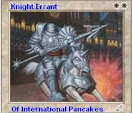After 23 years of research, I came up with the following conclusion:
In order to transfer knowledge from one position to another, the knowledge of a position must be deduced to a higher level of abstraction.
This is a system II activity. System I knows what to do with that higher level of abstraction already, by means of analogy. So system II must focus on abstracting analogies from a position.
I scrutinized every chess learning method I could find, and tested it with myself as guinea pig. After excluding everything that didn't work, the above statement remains.
I posed a lot of questions during these 23 years of investigation, and with the aid of the blue statement above, such questions can now get a definite answer. Like for instance:
- What are the conditions for a Stoyko exercise to work
- Why shows a brain scan of a grandmaster activity in the long term memory while a brain scan of an amateur shows that he perceives every position as new
- How to study master games
- Etc.
There are dozens question more posed in this blog that can finally get definite answers with the aid of the statement above.
Robert advised me the tome Surfaces and Essences: Analogy as the Fuel and Fire of Thinking of Hofstadter and Sander. Thx!!
They use 530 pages to convince even the most obnoxious and stubborn reader that Analogy is the Fuel and Fire of Thinking. Since I was already convinced at page 3, it was quite a reading.
It was good to see that the blue statement above has a scientific back up. I scrutinized the book for practical information how to apply it in practice, but the book gave merely hints how to extrapolate my narrow statement to a much broader domain. Transfer is the core process of all skill learning. The book provides lots and lots of inspiration, but that needs to be elaborated on. For practical information I have to think for myself. Again. Darn.
And that is what I'm going to do. I'm trying to shed light on the process by using tactical positions. I might even be tempted to use middle-game positions. Since the method is not limited to tactics, of course. We found the method. Now we need the proof. I'm excited!

I'm glad someone else appreciates the role of analogies in our chess thinking processes! (Sometimes I feel somewhat like John the Baptist, "a voice crying in the wilderness"!)
ReplyDeleteIn Chapter 6, How We Manipulate Analogies, there are some sections that bear close scrutiny with respect to chess.
Page 337: Are We Humans Really So Superficial?
Page 340: We Go as Deep as We Can Go
Page 344: Essences Are Revealed by Surfaces
You'll actually find references to "chess" in those pages. Not a lot, but more than sufficient to establish the needed connections. The salient concepts found throughout the book are the important ones; the "trick" is "seeing" those features at a deeper level than the surface perceptions. Analogies are used continually throughout the book.
It is the hard work of deducing the abstract connections/analogies that make the concepts "stick" in our memory and thereby useful for chess training purposes.
Supposedly, autistic children are able to "see" abstract concepts (rapidly analogizing) that adults cannot see. The many examples of the letter "A" (blended together on the cover, and also listed individually on page 5) were instantly recognized by my special-needs granddaughter. She can only print block letters of the English alphabet, and cannot recognize cursive letters, yet she had no problem with this.
The human mind is fantastically capable!
Sometimes I feel somewhat like John the Baptist, "a voice crying in the wilderness"!
DeleteYeah, sorry for that. I work mostly on a LiLo basis, which means that a comment can take considerable time to get an answer from me. But rest assured, from time to time, I wake up startled in the middle of the night, bathing in sweat, and hear you screaming in the distance.